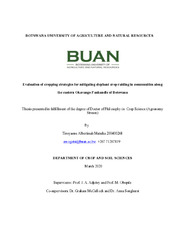| dc.description.abstract | There is an increased call for elephant protection and conservation due to the anthropogenically driven decline in elephant numbers globally. However, due to protection by Government legislation in Botswana, elephant populations in the Okavango and Chobe areas are far greater than the feasible carrying capacities of these areas. Consequently, smallholder farmers have grappled with food insecurity and other negative impacts of elephant crop raiding. The general objective of this study was to evaluate how cropping strategies could be used to mitigate the impact of crop raiding by elephants. An oral questionnaire was used to evaluate farmers’ perceptions of elephant raids in the region. In a second study, data from the assessment of raided fields were analysed for incidence risks (IR) and risk value (RV) using an adaptive epidemiological approach. In a third study, different crops viz. maize, sorghum and cowpea were planted in four different villages to examine the impact of crop maturity times on elephant raiding. Furthermore, a simulation of farmers’ fields consisting of sole crops viz. chilli, safflower, cowpea, groundnut, maize and sorghum as sole crops and the last four buffered with either safflower or chilli was carried out in elephant corridors in December 2017 to evaluate the mitigation impact of selected crops. The results of the survey showed that many farmers did not like elephants, and 95.4% have experienced crop raiding at some point. However, only 35.8% of farmers strategically placed their crops during planting to mitigate elephant raiding. Farmers’ willingness to adopt newer cropping strategies and crops was mainly influenced by being provided with inputs and only if those crops were food sources. The second study showed that crop raiding by elephants was decreasing but at a slow rate. The most affected crops by elephant raiding were millet and maize, while the least raided crops were cowpeas and groundnuts. The results also suggested that a slight increase in farmers growing cowpeas and groundnut rather than cereals led to a gradual decline in raiding incidents. Risk value for fields varied significantly depending on which crop was present on the farm. Increasing the number of crops planted in the field reduced the vulnerability of the whole field (R2 =-0.680, P=0.00) to crop raiding. Growing a crop with a high IR increased the whole field’s vulnerability, whereas adding crops with a lesser IR reduced the whole xiv field’s vulnerability to crop raiding. Results of the third study showed that early maturing varieties allowed harvesting at times when elephants were not frequently present near farms. The presence of elephants spotted near fields increased significantly as the growing season advanced, signifying an increasing risk of exposure for crops with longer maturity durations. Of the crops tested for their potential use to mitigate elephant damage, safflower was the most damaged while chilli, groundnut and cowpea suffered lesser damage. Non-buffered crops were damaged more, followed by safflower buffered crops, while chilli buffered crops suffered less damage. From these findings, it is concluded that: crop production in the eastern Okavango is not adequately responsive to elephant raiding despite over 95% of farmers having lost crops to elephant damage. However, it is suggested that while no single strategy would eliminate elephant raids, a combination of the carefully selected crops increases farmers’ resilience to food loss via elephant raid in the communities along the eastern Okavango panhandles of Botswana. The use of safflower as a buffer crop is a poor raid mitigation strategy. | en_US |

